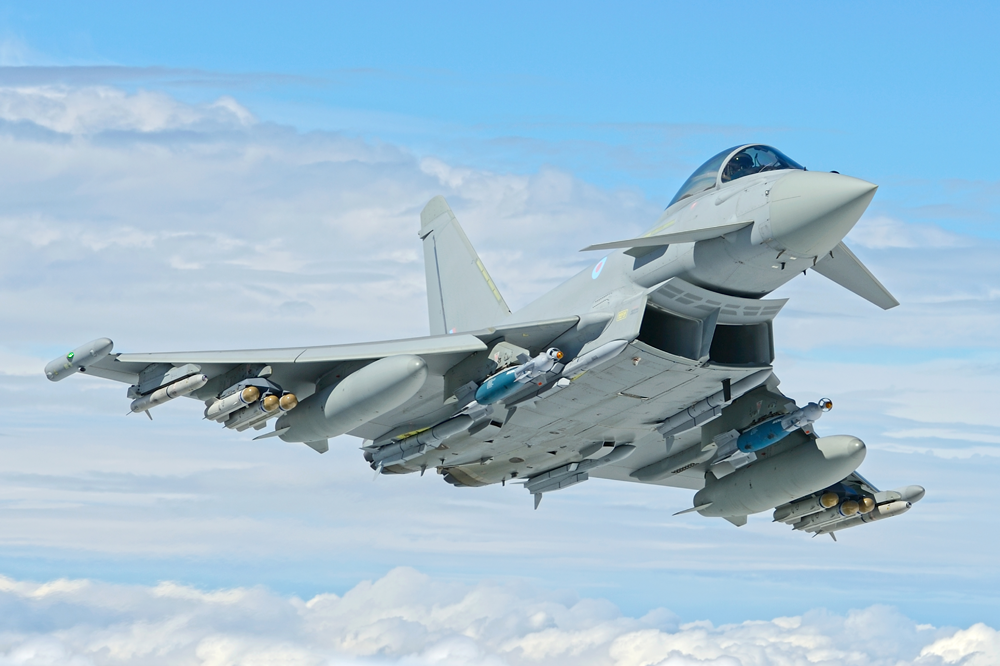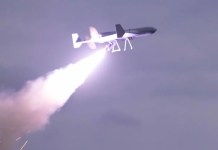In a powerful display of military readiness, the Royal Air Force (RAF) Eurofighter Typhoons recently participated in a training exercise to strike ground targets along the NATO border.
RAF Typhoon fighter jets from IX (B) Squadron, currently deployed in Estonia as part of the NATO Baltic Air Policing Mission, have been honing their Close Air Support (CAS) capabilities during Exercise Bold Hussar.
British, French, and Estonian Defense Force Joint Terminal Attack Controllers (JTACs) stationed at Tapa in eastern Estonia collaborated with the Typhoons for a period of three days during the exercise.
Estonian JTACs took charge of the ground operations throughout the joint exercise, with close support from their British and French NATO counterparts.
The exercise involving RAF Typhoons also showcased the fighter jets’ impressive ability to transition seamlessly from air-to-air combat to ground attack missions.
RAF Typhoons from IX (B) Squadron deployed on @NATO’s Baltic Air Policing Mission have participated in Exercise Bold Hussar to carry out Close Air Support Training with British, French and Estonian Joint Terminal Attack Controllers. ??????
Full story: https://t.co/gFw8SFlGef pic.twitter.com/vrlvHtMvGl
— Royal Air Force (@RoyalAirForce) April 29, 2023
In a press release, the Royal Air Force also said that the air-to-ground targeting simulations, carried out by the RAF Typhoons, showcased their precision-guided capabilities and ability to hit ground targets effectively.
Flight Lieutenant Wilkinson, IX (B) Squadron Pilot, said, “Exercise Bold Hussar is an example of the Typhoon’s ability to effortlessly switch from being a world-class fighter into a highly effective ground attack aircraft. Exercises like these are key to ensuring our pilots maintain their overall combat readiness.”
The British and French ground forces have been deployed to Estonia as part of the NATO Forward Presence mission, supporting the Estonian Defense Force.
RAF Typhoons In Estonia
The RAF Typhoons from IX (B) Squadron are part of the RAF’s 140 Expeditionary Wing. They are currently deployed on Operation Azotize to Amari Air Base in Estonia.
Their primary mission is to conduct NATO’s Baltic Air Policing mission, which involves the monitoring and interception of any unauthorized or potentially hostile aircraft operating near NATO airspace in the region.
For instance, the British and German Air Forces intercepted three Russian military aircraft in a mission over the Baltic Sea last month.
One of those three Russian aircraft was identified as a Russian Air Force IL-20 Coot-A intelligence aircraft. The aircraft was en route from mainland Russia to the Kaliningrad enclave and was escorted by two Russian SU-27 Flanker-B fighter jets based in Kaliningrad.
In addition to conducting the NATO Baltic Air Policing mission, RAF personnel deployed to Estonia will undertake challenging exercises designed to test their skills and equipment in high-end warfighting scenarios.

These exercises offer the RAF personnel the opportunity to work closely alongside NATO air and ground-based assets, providing valuable experience and training that they would not typically be able to undertake in the UK.
The 140 Expeditionary Air Wing will continue the mission, which will run until August, when they will hand over to the Spanish Air Force.
Ämari Air Base in Estonia has been a crucial hub for NATO’s assurance measures in response to Russia’s illegal annexation of Crimea in 2014.
Since then, the airbase has continuously hosted Allied fighter detachments, including the deployment of RAF Typhoons as part of NATO’s Baltic Air Policing mission.
According to NATO, during the frequent handovers and takeovers of the mission, Estonian personnel has consistently demonstrated their ability to provide first-rate support to the Allied mission, underscoring the importance of NATO’s partnerships and the crucial role played by its member states in collective defense.
Meanwhile, the multinational joint exercise ORION has recently kicked off with 12,000 participants taking part in air-land integrated training across France.
The exercise is based on a NATO collective defense scenario and involves troops from various allied nations, including the United States, the United Kingdom, Germany, and Spain.
The exercise, which started on April 19, will continue until May 5 and is designed to improve joint capabilities and interoperability among NATO allies and partners for high-intensity engagements.

Lieutenant General Emmanuel Gaulin, the commander of Exercise ORION 23, has emphasized the importance of having robust, modern, well-trained, interoperable, and certified armed forces to enable Allied nations to meet the requirements of strong and meaningful collective deterrence and defense.
Speaking about the exercise, Gaulin stated that the intensity and volume of forces involved in the final phase of ORION 23 are meeting the needs of multi-domain training in light of the challenges that NATO is currently facing and will face in the future.
- Contact the author at ashishmichel(at)gmail.com
- Follow EurAsian Times on Google News




